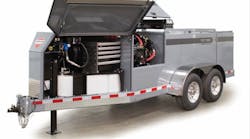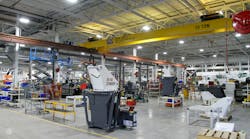THE precipitous plunge in the price of diesel fuel, steel, and aluminum is boosting the market for trucks, truck equipment, and trailers.
The national price of diesel had gone down from $4 at the beginning of 2014 to $2.42 as of early December.
“Diesel prices will continue to remain low, which means that more fleets will be earning a lot more money than they forecasted,” said Steve Latin-Kasper, director of market data and research for the National Truck Equipment Association (NTEA).
“They will have money to do things with their fleet. We’ve already seen that show up in fleet buys that were unexpected. They had cash on hand that none of them had expected or had written into their plans at this time last year. That price situation is going to remain in place and fleets will continue to have more cash on hand. They’re going to have a chance to do some things in expenditures. We should all ultimately benefit.”
“We’re matching lows that were established in 2010,” he said. “No one expects prices to go up anytime soon, aluminum especially, because of slowing growth in China. But aluminum will change more in the next few years much more so than will be the case in the steel industry because of what is going on in almost all of OEMs’ planning for the kind of metal and amount they are going to use in chassis and also in bodies and other types of equipment. Ford’s already come out with an aluminum F-150, and if you go to Alcoa’s website, their forecast for aluminum sales is practically a straight line up because the entire auto industry has put their orders in. They built a plant in the US just to supply US manufacturers.
“Expect low prices through 2016, then after that it could change drastically and swiftly because they will be starting to supply automakers with much more aluminum. The price of aluminum is likely to increase drastically by mid-2017. I’ve had a number of discussions with upfitters and they say, ‘It’s not that big of a deal.’ But for some others, I’m thinking it’s a big deal. It’s something you need to look out for if it’s relevant to you.”
In his presentation, “Work Truck Industry Insights and Outlook,” Latin-Kasper said total work truck industry shipments will be $133.9 billion in 2015—higher than expected. It was based primarily on bigger growth in truck and bus bodies ($13.1 billion) and truck equipment.
“For 2016, add about 5% to that number,” he said.
Strip chassis were down 4.4% through July, but everything else was up: cutaway and conventional were both up 11.7%, while LCOE was up 2.9%.
“That’s partially due to production issues,” he said of LCOE. “They’d probably be selling more, but there is one company in particular that is struggling to get shipments up to speed with sales.”
In total, chassis were up 9.1% through July. By GVW, Class 2 sales were down 2.7%—the only class with a decrease.
“It isn’t because demand is down,” he said. “Sales of pickups are so strong that other types of vehicles that are coming off those same lines are getting short shrift. Colorados are selling really well. They don’t want to stop the line and start cutaways and vans, which are coming off the same line. It’s causing some issues in the Class 2 segment of the market and to a certain extent Class 3, which for the first time in four or five years has cooled off (to a 2.4% increase).
“Tractors are growing at 24.3% and commercial vans (Class 1-3) 19.5%. The big difference between 2014 and 2015 in the commercial van segment is that in 2014, the standard roof height van sales were actually going down compared to 2013, and they’ve come way up. The higher roof sales continue to grow very well.”
In Canada, the picture is looking different. There isn’t the same decline in strips that exists in the US and Mexico markets. The overall market is growing at twice the rate through July, despite the fact that the Canadian economy is not doing well—handcuffed by the oil segment.
“Most of the rest of the Canadian economy is doing just fine,” he said. “Truck sales are still looking good in Canada. Class 4 is up 75.9% for the year, while Class 6 is the only segment that is down (11.9%). We’re seeing 18% growth in tractors. One big difference between the Canadian and US markets is that commercial van sales are not as high as in the US. They’re actually down a bit (2.3%), but it’s a small market. That could easily turn around and become positive again.”
Class 2-7 box-off chassis shipments in the US and Mexico. turned down in the first half of the year, not because demand turned down, but because of production issues.
“Most of you guys are running two shifts, and the OEMs are running three shifts at this point, and the simple fact is that you’re having trouble staffing the first shift,” he said. “Staffing the second and third shifts got dicey. Those shifts are nowhere near as productive as your first shift. In 2014, growth was going straight up and we didn’t have much to worry about. Demand for work trucks is still strong and still growing, but shipments are not keeping up with sales. So the growth rate has fallen to 7% to 8% after being above 20% to start the year. That’s behind sales and dropping.”
Class 8 shipments are growing this year at 22%. That includes tractors. If it just focused on Class 8 box-offs, the 12-month moving average would be tailing off, Latin-Kasper said.
The core of the market—straight truck chassis sales—has gone from averaging 10,000 units a month in 2010 to 22,000 in the first half of 2015.
“It’s going to keep growing for a little bit,” he said. “I fully expect to see this number get up closer to 25,000 as we get into the first half of 2016. That’s two-and-a-half times what we were dealing with in 2010. Cutaway has been ridiculously volatile, which has everything to do with production. It’s more of a shipments issue than a sales issue.”
He said ATA freight shipments are a leading indicator—they point to trailer demand level—and the rate of growth has been falling since the second quarter started.
“Trailer shipments are not likely to go negative, but will level off and continue at a much lower level of growth than 2014,” he said. “We’ll still have some growth, just not as fast as it has been.”
State and local government equipment spending look good, with no signs of slowing down.
“It tends to follow what happens with the rest of their equipment expenditures,” he said. “State and locals really weren’t spending much money on anything through 2012. In 2013, that started picking up and got better in 2014. The rate of growth appears to have leveled off, and I don’t expect it to go negative. It might even go up. It should continue to provide opportunities for most NTEA members going through 2016.
“State and local government spending on construction is mostly highway and street. That’s a big application market for trucks, and that looks really good going forward. Trucks that are being used to do highway and street building and maintenance aren’t owned by state and local governments. It’s done by contractors. There was a big increase in 2013 and it’s showing no signs of slowing down. The construction industry is looking pretty good, not just now but going forward.
“The private sector started to grow in the second half of 2015. People I talked to—associated general contractors and other constructions types that work for trade associations, and government people tied to the industry—are all saying this is looking good going forward. The national association for business economics forecast for the residential side of the construction industry says there are an additional 100,000 housing starts for 2015, from 1 million to 1.1 million. The expectation for 2016 is an additional 200,000 housing starts. That’s why we’re feeling good about medium-duty sales—because construction is their sweet spot.”
He said the NAFTA commercial truck chassis market velocity index suggests there is some level of imbalance in the industry—either OEMs’ expectations of future sales are out of touch with reality or something else is happening.
“In this particular phase of this business cycle, it isn’t a matter of demand falling causing expectations to fall—we’re seeing production bottlenecks,” he said. “You can’t sell the chassis if it didn’t get shipped. Shipments are falling behind sales in a number of segments. It’s particularly obvious in Class 2-3 and becoming obvious in Class 5-6. Lead times are stretching. It’s not quite as bad as 2006, but it’s clearly getting worse as we go forward.” ♦












